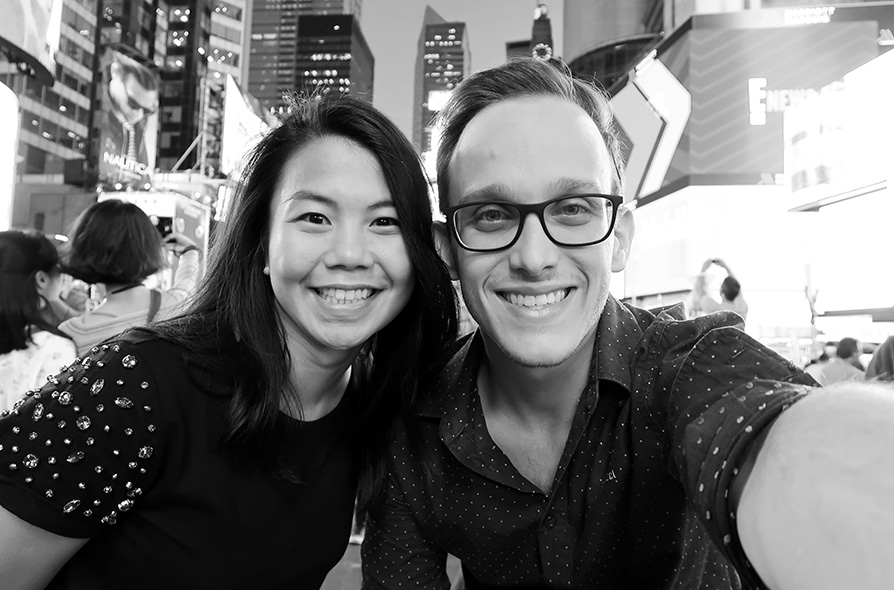20 December 2019 Neuroarchitecture seen through the Empathy Theory

In the middle of the 19th century, a group of intellectuals in Germany began to study the sensory and emotional impacts of the arts on human beings. As an extension of their studies, they also began to see the effects of architecture among their fans. A philosophical current emerged from there that received the term Einfühlung, being understood later by empathy.
I have invited two architects and scholars of this philosophical current, Caroline Ogura and Maurício Dallastra, to contribute with more in-depth explanations of how this valuable theory developed and started to assign meanings to neuroarchitecture projects. Follow the interview below:
Lorí Crízel ― How was the Einfühlung theory absorbed by other areas of human knowledge?
Caroline Ogura and Maurício Dallastra ― When looking for references on the subject, it is perceived that the movements around the subject take place in a common nucleus – Germany – in the middle of the 19th century. It is important to highlight that the term “Einfühlung”, developed in the scope of aesthetics to understand the emotional effect of forms – especially, but not only, spatial forms (GALLAND-SZYMKOWIAKM, 2017) –, appeared at a later point in the timeline.
However, it is worth noting that the conceptualizations found are diverse, being presented here the main references that corroborate the arduous task of drawing a timeline of this philosophical concept. Such a script permeates different areas of knowledge and, therefore, makes the job of listing precise dates and definitions about theories even more complex.
Einfuhlung is, therefore, the term whose meaning was initially associated with the study of empathy between human beings as social individuals, becoming later used to designate and describe the relationship between man and nature. According to NOWAK (2011) the origin of the term arises from the philosophical studies of Johann Gottfried Herder who describes empathy as a fundamental element for the interpretation of texts, history, and cultures, being used by scholars to explain the unification between subjects and objects (EDWARDS, L. H; 2013).
According to Mallgrave (2009), between 1846 and 1857, the German philosopher Friedrich Theodor Vischer published four volumes related to aesthetics – a branch of philosophy that aims to study the nature of beauty and the foundations of art – and in 1851, in one of these volumes, there is already a record of the theory covering the area of architecture, in which Vischer understands architecture as a “symbolic art” and that, through it, the role of the architect is to print vividness with linear resources and suspended plans. In 1866, the philosopher points to new psychological conceptions about how the brain tends to interpret artistic creations emotionally and symbolically. In short, his concept is that external factors end up influencing us in a very particular way and our emotional mood involuntary translates and interprets the symbolic image that the brain received. He also noted that vertical lines bring the feeling of elevating the human spirit, horizontal lines enlarge it, and curved lines move with more energy than straight lines.
In 1873, according to Mallgrave (2009), Friedrich’s son, the also philosopher Robert Vischer, introduced the term “Einfühlung” for the first time in his doctoral dissertation. It is worth mentioning that the word does not have a direct translation, being “empathy” or “feeling” its closest versions. For Robert, “Einfühlung” is the concept of interpreting objects of visual or artistic contemplation through collective and personal experiences and defends that empathic processes happen involuntarily. Thus, an object becomes perceived by the observer (who ceases to be a mere observer, assuming an active posture in the perceptual process), so that this relationship between individual and object is so intimate and striking that each detail is assimilated and registered. This experience becomes relevant in such a way that the contact with this object in a second moment allows to revive all the feelings previously perceived.
Enhancing his father’s conceptualization, Robert adds that a horizontal line may look pleasant because it conforms to the structure of our visual apparatus, on the other hand, a diagonal line would not bring such a pleasant sensation because it requires a less usual movement of the eyeball. The similar happens between an arc-shaped line and an irregularly shaped one. A form that has regularity is more interesting because it is similar to our body regularity.
Ionescu (2016) points out that Johannes Volkelt, a philosopher, conceived empathy as a basic faculty of human perception, constituent of any relationship with external objects, but not the only active function, as Lipps – who will be discussed below – defined. According to Lux and Weigel (2017), Volkelt’s studies are quite expressive for the theory, although he does not use the term “Einfühlung” in his postdoctoral thesis in 1876, he later adopts the term to discuss the subject in other publications.
Specifically approaching architecture, Heinrich Wölfflin, an important name in the field of art history and philosophy, in 1886 builds his doctoral thesis based on a central question about how it is possible that architectural forms can be the expression of an emotion or a state of mind. Mallgrave (2013) states that the historian considers our corporal organization and its set of neural and motor stimuli as factors that make us perceive a building. An example mentioned is the fact that, because we are aware of the force of gravity, we read the weight and balance of a building, judging an architectural project due to the basic conditions of organic life. In that same period, still according to Mallgrave (2013), the professor of architecture Adolf Göller also publishes a dissertation approaching the theme in a very formalistic way and defending that the appreciation of beauty in architecture was a fundamentally psychological factor that happens in the imagination at first .
In his thesis, Göller defends that in paintings and sculptures it was impossible to dissociate the form from the content it represents, the opposite in architecture, where lines and forms in their essence make up art.
It is well known that the concept of “Einfühlung” has gained popularity in the artistic, philosophical, and psychological circles and in this scenario one constantly finds the name of the German philosopher Theodor Lipps related to the theme. According to Galland-Szymkowiak (2017), between 1891 and 1897, Lipps developed the concept in order to explain optical illusions and perceptual and affective experiences of spatial forms, such as the forms used in architecture, industrial design and ornaments. Ionescu (2016) adds that, for Lipps, reflection on the aesthetics of space is essential and, in his 1891 thesis, he designates not only the projection of the individual feeling on an object, but also an emotional immersion on a symbolic level, meaning that the experience is an unrestricted emotional flow.
Studies on the theory gained international reach and, in 1909, structuralist psychologist Edward Titchener, in his research work on the topic, translated the term “Einfühlung” into “empathy”. Edwards (2013) describes that Titchener analyzed Lipps’ conception as an introspective method and disagreed with part of his research: while Theodor argued that sensory systems and information processing happened simultaneously, Edward separated visual image from kinesthetic information and added that only kinesthetic sensation would provide information in “Einfühlung”, even if they worked together or separately.
Also according to Edwards (2013), after a series of events that changed the direction of research regarding empathy, no mention of the topic was found in the scientific literature related to psychology between the years 1909 and 1948, only three theoretical articles, a not much expressive number considering the previous mobilization of the scientific community. Galland-Szymkowiak (2017), reinforces the statement mentioning that, in fact, the theory of architecture is practically the only domain in which an “Einfühlung” thought remained alive until the second half of the 20th century, complementing that the notion of empathy has undergone a renovation and has become multifaceted.
Mallgrave (2013) mentions that in 2007, a period closer to the current context, the historian David Freedberg and the neuroscientist Vittorio Gallese propose that the experience of art and architecture happens through the pre-cognitive activation of mirrored body mechanisms involved in the simulation of actions , emotions, and bodily sensations. Gallese is one of the discoverers of mirror neurons, which opened the possibility of relating this group of neurons to the behavior of imitation, and there is more and more evidence that it is related to more complex affective phenomena such as empathy. (CORRADINI & ANTONIETTI, 2013). Jelić (2015) describes the discovery of the mirror neuron phenomenon as an impacting factor in several areas of knowledge, and for architecture it is a way of explaining how we understand a building through our body shape and our sensory-motor experience, and in this scenario the studies of Vischer, Göller, Wölfflin, among others mentioned above, regain strength.
Therefore, Einfühlung refers to a complex, ambiguous concept which is also, however, fundamental for the current period, seen as it contributes to the development of ways to understand other people’s feelings and intentions from individual perceptions and experiences, leaving objectivity aside, as the current artistic manifestations and architecture have been based (NOWAK, 2011).
Lorí Crízel ― How do you assess the direct relationship between architecture and the empathy propagated by Einfühlung theorists?
Caroline Ogura and Maurício Dallastra ― As we can see when evaluating the timeline described in the question above, in general, the notion of empathy or “Einfühlung” was developed to understand the emotional effect of forms in the field of fine arts. Because it is strongly linked to the arts, the feeling is that architecture naturally “sought” this concept in order to understand and consequently optimize the relationship between space and user, as well as the way the building presents itself to the observer. I found Galland-Szymkowiak’s (2017) observation to be quite pertinent when pointing out that, among the fine arts, architecture is the one with the greatest duality between the individual and the object, seen as the latter represents great proportions, immobility. Although contrasting, architecture as an art can establish an intimate connection and arouse emotions and, therefore, empathy is used to promote such experiences.
Therefore, architecture did not appropriate this concept since such concept is naturally interwoven with the process of interpretation and perception of architecture. What is perceived is that architects, more than ever, have been working on designing spaces that, more than housing, promote experiences based on empathy. If for Vischer the concept of Einfühlung consists of the act of the observer projecting himself or herself on the object, feeling as an integral part of it, architecture would be the way to do it in a physical and multisensory way. Thus, each project tends to reveal the intentions and emotions of those who conceive them, transferring this to the users, who are involved in a process that explores the senses, promoting experiences and sensations that allow them to be registered in their memory.
Lorí Crízel ― What were the main gains that architecture had when adopting the Einfühlung theory for the idealization of the projects?
Caroline Ogura and Maurício Dallastra ― Spaces have become richer in details, in the sense that the act of entering a building, especially in the scope of commercial projects, becomes an experience explored from the human senses. Architectural styles, colors, textures, sounds, and smells are harmoniously combined in order to set up an atmosphere that conveys exclusive and, in general, pleasant sensations to the user, in such a way that architecture assumes a fundamental role here in the success of the enterprise.
In general, we can highlight that the notion of providing emotions through forms in any manifestation of art is quite significant. In architecture, I see it as an interdisciplinary resource of great value to optimize and mainly humanize spaces and buildings, in which there is a personalization of projects that makes it possible to add emotional and aesthetic value to it, to the detriment of spaces and buildings that often transmit the feeling that one simply adopted a “standard” to replicate, without considering conditions of the relationship between the individual and the environment.
Lorí Crízel ― How would you guide an architect to think about their project, bringing the concepts of Einfühlung into it? How would that happen?
Caroline Ogura and Maurício Dallastra ― As with any project, it is necessary to understand the wishes and needs of the client, be it the owner of the property or entrepreneur, in the case of commercial projects. In the latter, you would need to know the target audience of your business. In addition, it is essential that the architect seeks to constantly improve knowledge about the subjects that permeate this theme, through books, scientific articles, among others. Thus, I understand that einfühlung by itself already translates the creative process into the design of the project: if by means of it the observer, who in the case of architecture is the user of space, projects himself within the observed object, the architect, in turn, when conceiving a project from the perspective of empathy concepts, must also project himself as a user so that, from then on, he is able to assimilate the conceptual research of the project, adopting the architectural parties that best fit the pre-established conditions.
Understanding the principles of Einfühlung, one should seek to establish a strong connection with their client, the initial stage of data collection being fundamental to understanding the wishes and expectations regarding the project as a whole, including the program of necessities. A professional should be aware that what affects a individual positively may not be interesting to another one. Each case requires guidance and, as mentioned earlier, it is important to improve knowledge and understand the design conditions for this. In a residential project for example, the main intention is a feeling of comfort, security, and well-being and these factors depend a lot on the profile of the user or the group of people who will inhabit the residence – hence the need to pay attention to the point of view of the applicant through interviews, especially at the beginning of the design of the spaces. In a corporate project, the focus is collective, where an environment that promotes high efficiency and performance is expected, but many times they forget to consider factors such as inclusion and diversity. It has also been common to find highly effective spaces that deviate from “corporate standards”, such as the incubators of innovations that seek to stimulate creativity to a greater degree. One of the segments that intensively explores the concepts of empathy is retail design, which concentrates efforts to create emotionally captivating spaces that transform the user experience into a positive result for commerce. This type of project highly values the creation of experiences and many other segments were not mentioned, the intention is to exemplify how to detect within the empathy the object (project) and the observer (client/target audience).
Lorí Crízel ― In what way do you think architecture works when stimulating people’s cognitions?
Caroline Ogura and Maurícilo Dallastra ― We understand that architecture based on einfühlung concepts tends to promote exclusive experiences for users, so that each building is unique, both for its architecture and for its ability to promote sensations through the arrangement in which the elements are combined. Thus, architecture will influence the way in which a space is perceived by acting, unconsciously but directly, on the behavior of the individual inserted in this context. As an example, it is known that the colors of a bedroom wall are defined according to the desired sensations for a room intended for rest, so stimulating colors like red can be visually aggressive, making the space uncomfortable. In einfuhlung concepts, in addition to color, other elements are made compatible, making the space assume an exclusive, comfortable, and personalized atmosphere according to the intentions of the architect’s project.
Architecture has a range of resources and areas that can be explored in order to stimulate people’s cognitions, either in a natural or induced manner. Spaces that in their essence are well designed naturally promote the feeling of well-being and the connection with the individual, especially when paying attention to basic principles of environmental comfort and when seeking to explore the five human senses and not just the visual appeal. In this case, devices such as textures, colors, natural and artificial lighting, landscaping, acoustics, among others, contribute to this goal. The creation of “molded” spaces for the individual to experience according to their needs and desires positively affects the quality of their spatial and even social cognition. The same goes for situations on a larger scale that cover a larger group of people.
About Maurício Dallastra:
Maurício Dallastra is an architect and urban planner graduated in 2013 from Universidade Paranaense, campus of Cascavel/PR, city where he worked as a trainee at Crízel e Uren Arquitetos Associados. Participated in the Ópera Prima Contest (2012-2013) with his conclusion paper “School of Architecture for Cascavel – PR”. He is also a specialist in Lighting and Interior Design lato sensu by IPOG. Master’s degree in Environment and Development from the University of Vale do Taquari – UNIVATES, Lajedo – Rio Grande do Sul State, whose research permeates the areas of thermal comfort and energy efficiency in buildings. Works as an interim professor in the Civil Engineering course at the Mato Grosso State University – Campus Tangará da Serra since 2014, teaching the disciplines of Architectural Design, Urban Planning, and Energy Efficiency in Buildings, in addition to working as a professor at the University of Cuiabá, campus Tangará da Serra. He is the owner of ARQ3 Arquitetos Associados, where he works as an architect in the residential, commercial, and corporate architecture, lighting and interior design segments in Tangará da Serra and region. Member of ANFA – The Academy of Neuroscience for Architecture (2020). Participant of the ANFA 2020 conference with approved work for presentation.
About Caroline Ogura:
Caroline Ogura has an undergraduate degree in Architecture and Urbanism from Universidade Paranaense (UNIPAR) – Campus Cascavel/PR. She has participated of the Ópera Prima Contest 2011-2012 (Theme: Multisensory Cultural Space). Trainee at the architectural office Crízel e Uren Arquitetos Associados (2008/2011). Executive project manager at the architectural office Crízel e Uren Arquitetos Associados (2012/2013). Co-owner of the architectural office Garcia e Ogura Arquitetura (2015/2019). Currently manager of the areas of design, art finishing, and content production for the architectural office Lorí Crízel + Partners. Member of ANFA – The Academy of Neuroscience for Architecture (2020). Participant of the ANFA 2020 conference with approved work for presentation.




